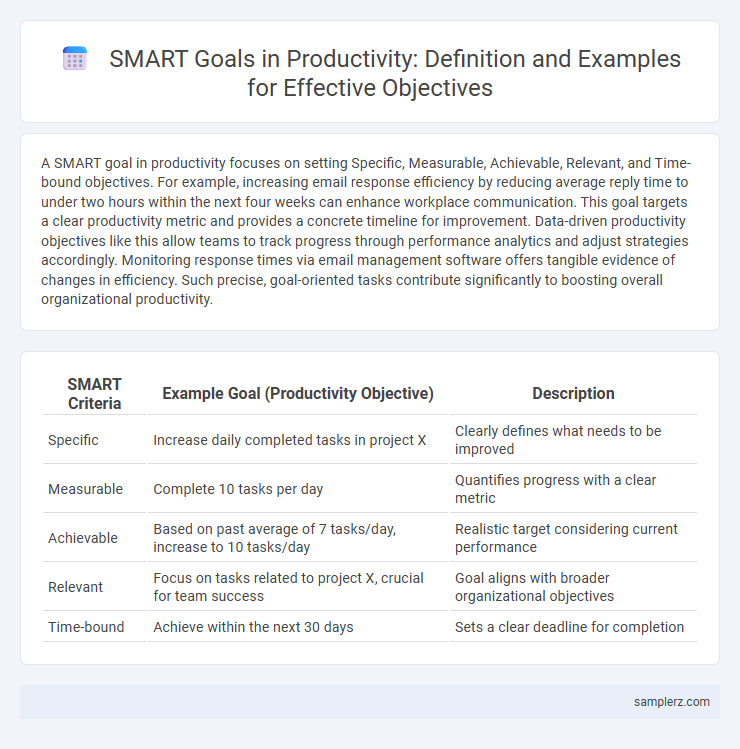A SMART goal in productivity focuses on setting Specific, Measurable, Achievable, Relevant, and Time-bound objectives. For example, increasing email response efficiency by reducing average reply time to under two hours within the next four weeks can enhance workplace communication. This goal targets a clear productivity metric and provides a concrete timeline for improvement. Data-driven productivity objectives like this allow teams to track progress through performance analytics and adjust strategies accordingly. Monitoring response times via email management software offers tangible evidence of changes in efficiency. Such precise, goal-oriented tasks contribute significantly to boosting overall organizational productivity.
Table of Comparison
| SMART Criteria | Example Goal (Productivity Objective) | Description |
|---|---|---|
| Specific | Increase daily completed tasks in project X | Clearly defines what needs to be improved |
| Measurable | Complete 10 tasks per day | Quantifies progress with a clear metric |
| Achievable | Based on past average of 7 tasks/day, increase to 10 tasks/day | Realistic target considering current performance |
| Relevant | Focus on tasks related to project X, crucial for team success | Goal aligns with broader organizational objectives |
| Time-bound | Achieve within the next 30 days | Sets a clear deadline for completion |
Understanding SMART Goals in Productivity Objectives
A SMART goal in productivity objectives is setting a target to increase task completion rates by 20% within three months by implementing time-blocking techniques. This goal is Specific, Measurable, Achievable, Relevant, and Time-bound, ensuring clear focus and accountability. Understanding SMART goals enhances productivity by providing structured, actionable steps toward efficient time management and performance improvement.
Examples of Specific Objectives Using SMART Goals
Increase weekly sales calls by 20% within three months to boost client engagement and revenue. Complete daily project tasks with 95% accuracy by the end of the quarter to enhance team efficiency. Achieve a monthly customer satisfaction score of 90% or higher by improving response times and service quality.
Measurable Productivity: Sample SMART Goals
Increase daily output by completing 15 high-priority tasks within 8 working hours to enhance measurable productivity. Track progress through daily task logs and weekly performance reviews to ensure consistent improvement. Achieve a 20% boost in productivity metrics within three months by maintaining this targeted workflow.
Achievable Targets: Illustrative SMART Objective Examples
Achievable SMART goals enhance productivity by setting clear, realistic targets like increasing weekly sales calls from 20 to 30 within three months. These objectives emphasize measurable outcomes, ensuring progress is trackable and attainable based on current resources and capabilities. Focusing on achievable targets prevents overwhelm and motivates consistent performance improvements.
Relevant Objectives: Applying SMART Goals to Productivity
Set a SMART goal to increase weekly project output by 20% within three months by prioritizing high-impact tasks aligned with team objectives. This goal is relevant because it directly supports overall business growth and enhances individual efficiency. Tracking progress weekly ensures focus remains on objectives that contribute meaningfully to productivity improvements.
Timely Goal-Setting: SMART Objective Examples for Productivity
Setting a timely SMART goal enhances productivity by establishing clear deadlines that promote accountability and progress tracking. For example, aiming to complete a monthly sales report by the last Friday of each month ensures focused workflow and timely deliverables. Defining a specific timeframe like "within two weeks" accelerates task completion and optimizes time management.
SMART Goal Templates for Productivity Enhancement
Boosting productivity through SMART goal templates involves defining Specific, Measurable, Achievable, Relevant, and Time-bound objectives, such as increasing weekly task completion by 20% within three months by using digital planning tools. These templates provide a structured framework that enhances clarity and accountability in goal setting, leading to consistent progress tracking and improved efficiency. Implementing SMART goals in productivity approaches allows individuals and teams to prioritize high-impact activities aligned with organizational objectives, driving measurable performance improvements.
Real-Life Case Studies: Productivity SMART Goals
Increasing team productivity by 15% within six months was achieved by implementing a SMART goal in a software development company, which involved setting Specific tasks, Measurable milestones, Attainable workload distribution, Relevant project objectives, and Time-bound deadlines. A sales team improved monthly lead conversion rates from 20% to 35% by focusing on clearly defined customer engagement strategies and regularly tracking key performance metrics aligned with SMART criteria. Real-life case studies demonstrate how setting SMART goals drives accountability, enhances focus, and optimizes resource allocation to boost overall productivity.
Common Productivity Objectives as SMART Goals
Increase daily task completion by 20% within three months through implementing time-blocking techniques and minimizing distractions. Enhance weekly team meeting efficiency by reducing duration from 60 to 45 minutes while maintaining goal alignment and actionable outcomes. Improve email response time to under one hour for 90% of client communications over the next quarter, boosting overall responsiveness and customer satisfaction.
Step-by-Step Guide to Crafting SMART Productivity Objectives
A SMART productivity objective follows specific, measurable, achievable, relevant, and time-bound criteria, such as increasing weekly output by 20% within three months through daily task prioritization. Breaking down this goal involves identifying clear metrics, setting realistic benchmarks, aligning tasks with overall productivity goals, and establishing deadlines for progress reviews. This step-by-step guide ensures clarity, focus, and accountability in achieving enhanced productivity.

example of SMART goal in objective Infographic
 samplerz.com
samplerz.com